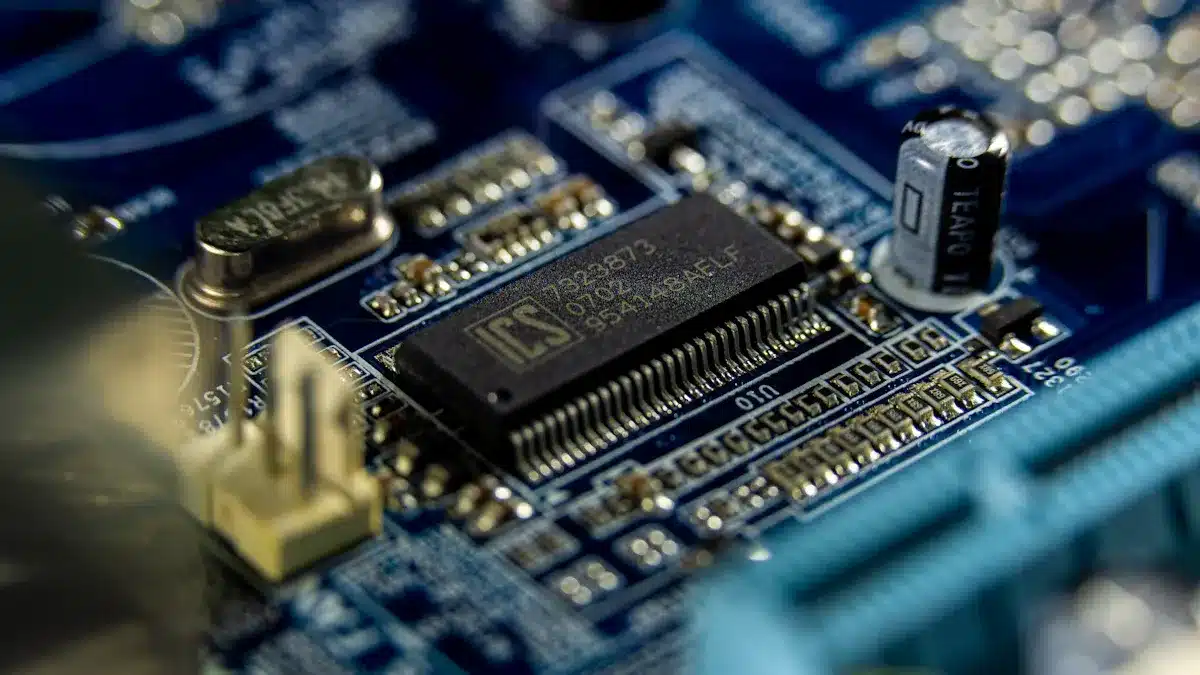
In today’s fast-moving tech world, more people want circuit board design programs. You can see this growth in the numbers: North America has about 35% of the global market share. Asia Pacific is next with 30%. This increase comes from the growing needs in consumer electronics, cars, and healthcare. As electronic devices get more complicated, the need for better design tools grows. You can use these programs to improve efficiency and creativity in your projects.
Key Takeaways
Altium Designer has great routing tools and 3D views. This makes it good for beginners and skilled designers.
Eagle PCB has an easy-to-use interface and many libraries. It is perfect for hobbyists and professionals.
KiCad is a free, open-source choice that works on many platforms. This makes it great for DIY projects and school use.
OrCAD is very good at simulating designs. It helps engineers improve complex designs and lower risks.
EasyEDA has online tools for teamwork. This lets teams work together in real-time and makes the design process easier.
Altium Designer

Altium Designer is a top choice among circuit board design programs. It has great features and is easy to use. This software gives you strong tools that make designing better.
Features
One important feature of Altium Designer is its advanced routing and design rule management. Here are some key points:
Best in Class Interactive Routing
Advanced routing tools that meet impedance targets, via sizes, and templates
An online DRC engine that finds errors and shows them in the PCB layout
A routing engine that matches lengths with delay or length tuning options
High-density design tools that help route advanced parts like fine-pitch BGAs on boards with many layers
Full control over via transitions with easy definitions for backdrilling and antipad designs
Another cool feature is its 3D visualization capabilities. Altium Designer scores 80% for its 3D modeling tools, much higher than the average of 64% for competitors. This lets you see your printed circuit boards in 3D. It helps you spot problems before making them.
Use Cases
Altium Designer works well for different types of projects. Here are some common uses:
Project Type | Description |
|---|---|
PCB Project | Captures electronic circuits as schematics and moves them to PCB layouts. |
Multi-board Project | Links several PCB projects into one design for assembly. |
Integrated Library | Creates a complete library of parts for use in designs. |
Script Project | Saves programming scripts to automate tasks in Altium Designer. |
With its strong features and easy-to-use design, Altium Designer is a great pick for beginners and skilled designers. You can use its tools to make complex designs quickly.
Eagle PCB
Eagle PCB is a great choice among circuit board design programs. It has a user-friendly interface and a large library of parts. This software is easy to use for both new and skilled designers. You can find your way around its features easily. This makes it a good option for many users.
Features
Eagle PCB has several important features that help you design better:
Integrated schematic and board editor: Changes in schematics update the board layout automatically.
Extensive component libraries: You get thousands of parts right away.
User Language Programs (ULPs): You can make custom scripts to add more functions.
Robust design rule checking: This helps stop mistakes during manufacturing.
Integration with Autodesk Fusion 360: You can use advanced 3D modeling tools.
Follow-me router: This helps place traces more easily.
Multi-sheet schematics: You can handle complex designs without trouble.
Back annotation: Changes on the board can update the schematic.
Design re-use: You can copy circuits from past projects.
These features make Eagle PCB a strong choice among the best PCB design software today.
Use Cases
Eagle PCB works well for many types of users, from hobbyists to professionals. Here are some common uses:
User Type | Description |
|---|---|
Hobbyists | Great for DIY fans who like its fair pricing and large library. |
Professionals | Good for engineers working on complex designs, thanks to its strong features and community help. |
Many users like Eagle for its user-friendly interface and helpful community. But some say it has quirks that take time to get used to. For example, while Eagle is easy to start using, you might find some features missing compared to other software.
Overall, Eagle PCB gives a solid platform for both beginners and experienced designers. It lets you create effective designs with confidence.
KiCad
KiCad is one of the best options for PCB design software today. This strong tool is free and open-source, so everyone can use it. You can download it at no cost and enjoy its great features. KiCad is always being improved, which means you get ongoing support. Notably, groups like CERN have used KiCad successfully, showing it is a reliable choice instead of paid tools.
Features
KiCad has many advanced features that make your design work better:
Schematic Capture: You can easily create and edit schematics.
PCB Layout: The layout tools help you place components accurately.
Cross-Platform Compatibility: KiCad works on Windows, Linux, and macOS, giving users flexibility.
Comprehensive Library Management: You can make custom symbols and footprints. This ensures proper links between schematic symbols and PCB footprints. This feature makes KiCad different from many paid programs, which usually have combined libraries with lots of models and lifecycle data.
Use Cases
KiCad is good for many types of projects and users. Here are some common uses:
Project Type | Description |
|---|---|
DIY Projects | Hobbyists often use KiCad for personal electronics projects because it is free. |
Educational Purposes | Students and teachers use KiCad to learn about circuit design. |
Professional Designs | Engineers and designers use KiCad for complex projects, taking advantage of its advanced features. |
You can find many projects made with KiCad on sites like GitHub and GitLab. The KiCad website has a section called ‘Made with KiCad,’ showing about 50 notable projects. This community-driven approach encourages teamwork and sharing knowledge. Users can help improve libraries and give feedback to make the software better.
OrCAD
OrCAD is a top choice among circuit board design programs. It has strong simulation features. This software helps you check and improve your designs easily. You can count on OrCAD to help you make reliable and efficient electronic systems.
Features
OrCAD has many advanced features that make your design work better. Here are some important simulation types you can use:
Analysis Type | Description |
|---|---|
Transient Analysis | Shows how circuits change over time, like voltage or current. |
Smoke Analysis | Checks if parts are safe under different conditions to ensure they work well. |
Sensitivity Analysis | Looks at how changes in parts affect circuit performance, helping save money. |
Monte Carlo Analysis | Uses statistics to predict how circuits perform under different conditions, improving yield and cost. |
Optimizer | Changes circuits to meet specific design needs, finding the best part values. |
Matlab Integration | Lets you simulate electrical and mechanical systems together for a complete analysis. |
These features make OrCAD one of the best PCB design software options today.
Use Cases
OrCAD is great for complex designs, making it a favorite for many engineers. Here are some important uses:
Case Study Title | Description |
|---|---|
Minimizing Routing Iterations on Complex, High-Density PCBs with OrCAD Tools | This case study by G5 Engineering shows how OrCAD tools helped cut down routing steps in complex PCB designs, proving its efficiency in high-density work. |
Meeting Board Space Constraints and Time-to-Market Targets with OrCAD PCB Design Tools | Home2net’s case study shows how OrCAD tools helped them meet strict space limits while keeping to tight deadlines, showing the tool’s effectiveness in managing projects. |
Mitigating Design Risks Quickly via Scalable Circuit Simulation with PSpice and OrCAD Solutions | Solid State Logic’s experience shows how using OrCAD for circuit simulation helped them quickly solve design risks, highlighting the tool’s role in managing risks during design. |
With its strong simulation features and use in complex designs, OrCAD is an important tool for engineers. You can trust its features to make your work easier and improve your design accuracy.
EasyEDA
EasyEDA is a great choice among circuit board design programs. It has a user-friendly interface and strong features. This online tool helps you design PCBs easily while working with others.
Features
One of the best things about EasyEDA is its online collaboration capabilities. You can work with your team in real-time, no matter where you are. Here are some important parts of this feature:
Feature | Description |
|---|---|
Team Role | You can set roles like Managers, Developers, and Observers. This helps with task management and security. |
Team Data | All project data belongs to your team and can be uploaded as team documents. |
You can manage team members and project data in real-time. This gives you a clear view of project status. | |
Efficient Co-Design | Work together from any place or device. Team members can easily comment on designs. |
Another important part is EasyEDA’s integration with manufacturing services. This feature makes it easier to go from design to production. For example, EasyEDA works with JLCPCB’s PCB manufacturing service. This helps make the workflow better. You can order PCBs and parts directly through the platform, saving time and effort.
EasyEDA also has advanced features like real-time design rule checks. This gives quick feedback on design mistakes, helping you fix problems as you go. Users like the easy interface, which makes it simple to navigate.
You can use EasyEDA on any device with internet access. This means you don’t need complicated installations or fancy hardware. It is especially helpful for hobbyists, students, and startups, letting them use the platform easily no matter where they are.
Use Cases
EasyEDA is good for many users, from beginners to skilled engineers. Here are some common uses:
User Type | Description |
|---|---|
Hobbyists | Perfect for DIY fans who enjoy the ease of use and teamwork features. |
Students | Great for learning, allowing students to explore PCB design without high costs. |
Professionals | Good for engineers who need a strong platform for complex designs and fast prototyping. |
With its mix of teamwork, manufacturing links, and easy-to-use features, EasyEDA is a great choice for anyone wanting to start PCB design.
Comparison of PCB Design Software

When picking the right PCB design software, think about different features and criteria. Each program has good and bad points. Below is a table that shows key features of popular PCB design software.
Overview Table
Software | PDNA | Differential Pair Routing | Unified Environment | Customizability | Board Size | Advanced Via Design | Layers Supported | |
|---|---|---|---|---|---|---|---|---|
Altium Designer | Yes | Yes | Yes | Yes | High | Large | Yes | 32 |
KiCAD | Yes | No | Yes | No | High | Medium | Yes | 16 |
Eagle | Yes | No | Yes | No | Medium | Medium | No | 6 |
OrCAD | Yes | Yes | Yes | Yes | Medium | Large | Yes | 16 |
EasyEDA | Yes | No | No | No | Low | Small | No | 4 |
This table shows important features that can help you make a smart choice.
Choosing the Right Tool
Picking the best PCB design software depends on what you need. Here are some things to think about:
Experience with Complex Designs: If you work with detailed layouts, make sure the software can manage heat and complex paths.
Flexibility: Look for software that can change with your project needs. Advanced tools can improve your design work.
Prototyping and Testing: Quick prototyping and careful testing are important for improving designs and making sure they work well.
Library of Verified Designs: A library of checked designs can save you time and help you avoid mistakes later.
Budget and Growth: Choose a tool that fits your budget now and can grow with your future needs.
Feature Set: Important features include a strong component library, support for multiple layers, simulation tools, and 3D modeling.
Cost: Think about the software’s price, including any extra costs. Remember, a higher price doesn’t always mean better quality.
Compatibility: Make sure the software meets your project needs and can handle the complexity of your designs.
By looking at these points, you can find the PCB design software that works best for your projects and workflow.
Picking the right PCB design software can really change your projects. Each program has special features for different needs. Recent surveys show that the best software options got high satisfaction ratings, but users found some issues with how easy they are to use. The quality of support is very important for keeping users happy.
As technology changes, expect trends like miniaturization, flexible PCBs, and advanced materials to influence future designs. Here are some good things about using advanced PCB design software:
Error Reduction: Automated checks find design mistakes early.
Improved Collaboration: Real-time sharing helps teamwork.
Accelerated Time-to-Market: Faster updates give you an advantage.
By knowing these points, you can make smart choices that improve your design process and project results. Happy designing!
FAQ
What is PCB design software?
PCB design software helps you make printed circuit boards. It lets you create schematics, arrange components, and test how circuits work. You can pick from different programs based on what you need and how much experience you have.
Can I use these programs for free?
Some PCB design programs, like KiCad and EasyEDA, are free to use. Others, like Altium Designer and OrCAD, have paid versions with extra features. Check the websites of each program for prices and free trial options.
How do I choose the right PCB design software?
Think about what your project needs, your budget, and your skill level. Look for features like 3D modeling, simulation tools, and libraries of components. Read reviews and compare choices to find the best one for you.
Is there a learning curve for these programs?
Yes, many PCB design programs can be tricky to learn. But most have tutorials, guides, and community help. Start with easy-to-use software to build your skills before trying more complex tools.
Can I collaborate with others using PCB design software?
Many programs, like EasyEDA, have online teamwork features. You can work with team members in real-time, share designs, and manage projects together. This makes working as a team easier and more effective.
See Also
Key Considerations When Selecting Your Ideal PCBA Solution
Streamlined PCBA Solutions for Your Electronics Projects
Crucial Advice for Selecting the Perfect PCBA Board
Ten Professional Strategies for Cost-Effective PCBA Assembly
Effective Techniques to Improve Your PCBA Engineering Skills